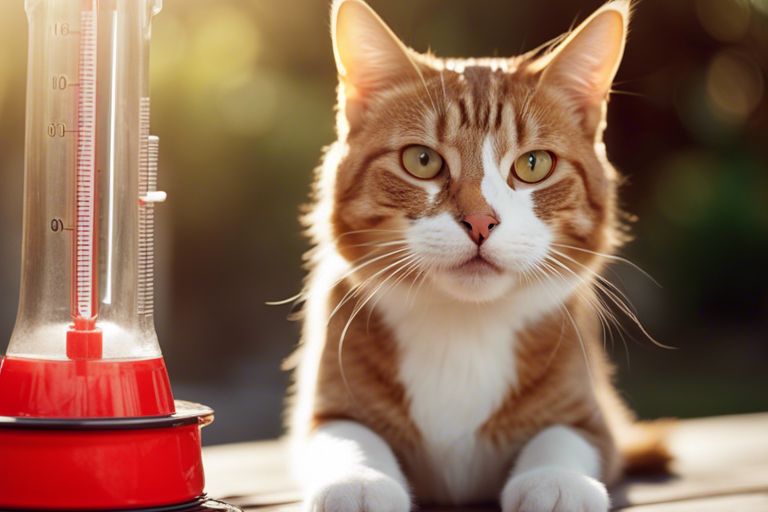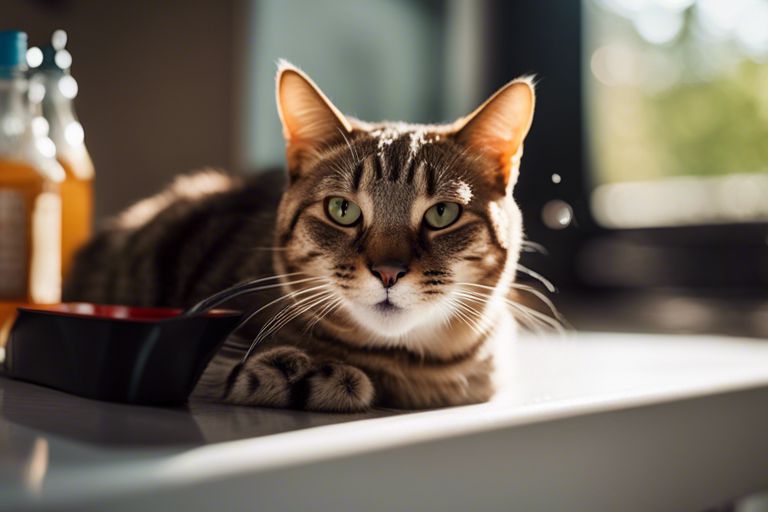Ensuring the well-being of your feline companion during hot weather is crucial. Heatstroke in cats can be a life-threatening condition and it’s essential to be able to recognize the signs. Some of the most important indicators that your cat may be suffering from heatstroke include excessive panting, drooling, lethargy, vomiting, and in severe cases, collapse. It’s crucial to act quickly if you notice any of these symptoms in your cat. In this blog post, we’ll discuss the signs of heatstroke in cats, as well as what you can do to help prevent it and how to provide immediate care if your cat is affected. By being aware of these signs, you can protect your feline friend from a potentially life-threatening condition.
Key Takeaways:
- Excessive Panting: Cats may excessively pant when experiencing heatstroke as a way to regulate their body temperature.
- Lethargy: A heatstroke may cause cats to appear lethargic and less active than usual.
- Vomiting and/or diarrhea: Heatstroke can cause digestive issues such as vomiting and diarrhea in cats.
- Rapid heart rate and breathing: Cats may exhibit rapid heart rate and breathing when suffering from heatstroke.
- Drooling: Excessive drooling can be a sign of heatstroke in cats as they try to cool down their body.
Recognizing the Signs of Heatstroke
One of the most crucial things you can do as a responsible pet owner is to understand the signs of heatstroke in your cat. As the temperature rises, it’s important to be vigilant and prepared to recognize the warning signs that your feline friend may be suffering from heatstroke.
Behavioral Changes
When it comes to recognizing heatstroke in cats, behavioral changes are often the first and most noticeable signs. You may notice your cat becoming increasingly lethargic, anxious, or even agitated. They may also seek out cool surfaces to lay on, or may pant excessively as they try to regulate their body temperature. If you notice any sudden changes in your cat’s behavior, it’s important to take their temperature and seek immediate veterinary care if they’re showing signs of heatstroke.
Physical Symptoms
Aside from behavioral changes, there are also physical symptoms you should be aware of. One of the first signs of heatstroke in cats is an elevated body temperature, typically above 104°F. Other physical symptoms may include drooling, vomiting, diarrhea, redness of the tongue and mouth, and even seizures. Keep an eye on your cat’s physical condition, especially during hot weather, and seek veterinary attention if you notice any concerning symptoms.
Risk Factors for Heatstroke in Cats
While heatstroke can affect any cat, certain factors can increase the risk for this potentially life-threatening condition. Here are some factors that can put your cat at a higher risk for heatstroke:
- High temperatures: exposure to extreme heat and humidity can increase the risk of heatstroke in cats.
- Restricted access to water: if your cat doesn’t have enough access to fresh water, they may become dehydrated, making them more susceptible to heatstroke.
- Obesity: overweight cats are at a higher risk of heatstroke due to reduced ability to regulate body temperature.
- Existing medical conditions: cats with respiratory or heart conditions are more vulnerable to heatstroke because they may have a harder time regulating body temperature.
Recognizing these risk factors can help you take the necessary precautions to prevent heatstroke in your cat.
Environmental Conditions
Environmental conditions play a significant role in the likelihood of heatstroke in cats. High temperatures and humidity levels increase the risk, especially if your cat is left outdoors for a prolonged period without access to shade or water. Even indoor cats can be at risk if they are in an environment without proper air conditioning or ventilation during hot weather.
Cat-Specific Vulnerabilities
Cats have certain vulnerabilities that make them more prone to heatstroke. Their fur coat can hinder their ability to dissipate heat, especially in long-haired breeds. Additionally, cats have a limited ability to sweat and predominantly release heat through panting, which can be less effective in regulating body temperature compared to other animals. Understanding these vulnerabilities can help you take necessary precautions to protect your cat from heatstroke.
Immediate Actions to Take
Despite your best efforts to prevent heatstroke, it can still happen. If you suspect your cat is suffering from heatstroke, you must act quickly. The consequences of heatstroke can be severe, and immediate action is crucial. For more information on the symptoms of heatstroke in cats, visit Heatstroke in Cats – Symptoms & What You Should Do.
First-Aid Measures
If you suspect your cat is suffering from heatstroke, the first thing you should do is move them to a cooler, shaded area. You can also place cool, wet towels over their body to help lower their body temperature. It’s important not to use ice-cold water or ice packs, as these can actually be counterproductive and cause the blood vessels to constrict, making it harder for your cat to cool down.
When to Seek Veterinary Care
If your cat is showing signs of heatstroke, such as panting excessively, drooling, or vomiting, it’s crucial to seek veterinary care immediately. Heatstroke can quickly become life-threatening, and your cat will need professional medical treatment to recover. Your vet may need to administer intravenous fluids, oxygen therapy, and other supportive measures to stabilize your cat’s condition.
Remember, the key to successfully treating heatstroke in cats is acting quickly. If you suspect your cat is suffering from heatstroke, don’t wait—take immediate action to help save their life.
Prevention and Care
Unlike humans, cats cannot sweat to regulate their body temperature. This makes them more susceptible to heatstroke. To prevent heatstroke in your cat, it is important to take certain precautions and provide proper care during hot weather.
Safe Environments for Cats
During the hot summer months, make sure your cat has access to cool and shaded areas both indoors and outdoors. Keep your home well-ventilated with fans or air conditioning, and provide a cool surface, such as tiles, for your cat to lie on. If your cat spends time outdoors, ensure they have access to shaded areas, plenty of fresh water, and always have the option to come inside to cool off. Never leave your cat in a car, even with the windows cracked, as temperatures can quickly reach dangerous levels, leading to heatstroke.
Monitoring and Ongoing Prevention Strategies
It’s essential to keep a close eye on your cat during hot weather. Look for signs of heatstroke such as excessive panting, drooling, lethargy, and vomiting. If you notice any of these symptoms, it’s crucial to act quickly. Immediately move your cat to a cooler environment, offer small amounts of water to drink, and place cool, wet towels on their body. It’s also important to take your cat to the veterinarian as soon as possible for a thorough evaluation and treatment. Additionally, you can use preventative measures such as grooming your cat regularly to remove excess fur, providing access to fresh water at all times, and limiting exercise during the hottest parts of the day.

Conclusion
With these considerations, it is important for you to be aware of the signs of heatstroke in cats, especially during the hot summer months. By being vigilant and observant, you can ensure the well-being of your feline companion and take immediate action if you notice any symptoms such as excessive panting, drooling, or lethargy. Remember to provide your cat with access to shade, plenty of water, and a cool environment to prevent heatstroke. Keep an eye on your cat’s behavior and seek veterinary attention if you have any concerns about their health during hot weather. Being proactive and informed can prevent serious heat-related health issues in your beloved pet.
FAQ
Q: What are the signs of heatstroke in cats?
A: The signs of heatstroke in cats include excessive panting, drooling, lethargy, weakness, vomiting, and in severe cases, collapse or seizures. It’s important to seek immediate veterinary care if you suspect your cat is suffering from heatstroke.
Q: How can I prevent heatstroke in my cat?
A: To prevent heatstroke in cats, ensure they have access to cool, shaded areas and plenty of fresh water. Avoid exercising or leaving your cat in hot, humid conditions, and never leave them in a parked car, as temperatures can quickly become dangerous. Additionally, consider providing a cooling mat or elevated bed for your cat to help regulate their body temperature.
Q: What should I do if I suspect my cat has heatstroke?
A: If you suspect your cat has heatstroke, immediately move them to a cooler area, offer them water, and gently wet their fur with cool (not cold) water. It’s crucial to seek veterinary attention as soon as possible, as heatstroke can quickly become life-threatening if not treated promptly.

Jayley, a devoted cat enthusiast, also writer for other cat blog as well. She aims to dedicated to providing comprehensive information, insights, and advice on everything you’d ever want to know about our whiskered companions.
